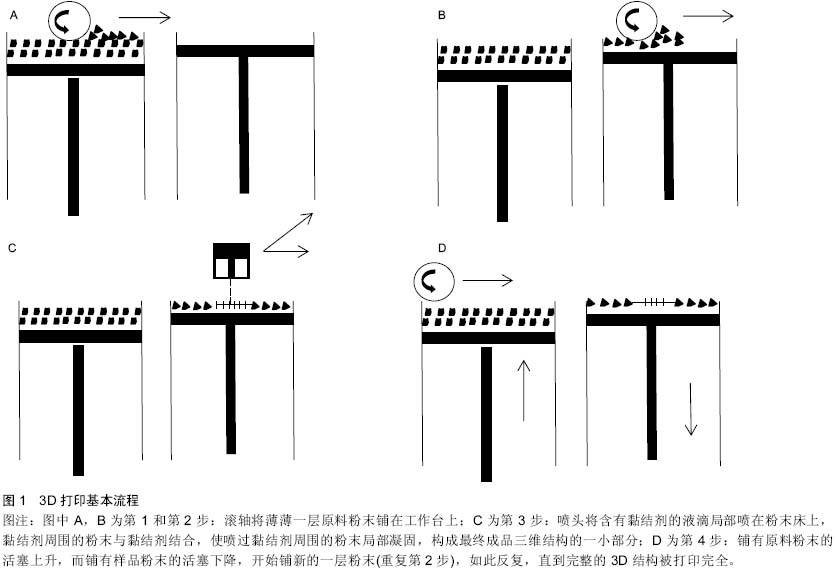
2.1 纳入资料基本概况 符合纳入标准的33篇文献中,文献[1-3]是关于骨缺损治疗相关报道,文献[4-7]是有关传统支架制备方法的相关报道,文献[8-12]是关于支架所需具备的条件相关报道,文献[13-18]是关于3D 打印技术优势及要求的相关报道,文献[19-31]是关于不同材料的特性及应用进展的相关报道,文献[32-33]是有关3D存在局限性与未来发展方向的相关报道。
2.2 纳入资料的研究结果特征 是影响因素。②合适的力学强度。③符合取代部位的解剖学形态[10-11]。另外,普遍认为3D骨支架孔隙率应大于40%-60%以利于细胞快速扩散和细胞营养物质的流动,同时有利于细胞的转移[12]。所以设计与制备支架时需注意与重视骨组织工程支架的要求,选择最恰当的方法与材料。
2.2.2 骨组织工程支架中的3D打印技术
3D打印技术概况:3D打印技术是最早于1989年由麻省理工学院的Emanual Sachs等报道,是一种按需喷射的微滴喷射技术。3D打印系统是在廉价的商用打印机系统上加以改进,增加z轴的运动控制系统,采用系统原有的喷墨装置或经过改装的注射器阵列实现材料的离散形成。利用这种技术在制备骨组织工程支架时,一般通过打印机将储存于其中的具有骨修复功能的粉末材料和黏结剂逐层打印出模型结构,黏结剂用于将粉末粒子之间和层与层之间黏结,使其更加稳固,最终可形成所需要的骨组织工程三维支架材料。打印材料的微观结构可以通过很多参数进行调节,例如改变黏结剂的流速,打印的速度及沉积位置等。
3D打印技术相较于其他快速成型技术,具有的优势有:①高精度:即高分辨率。②可以同时打印种子细胞和支架材料,更利于整体三维结构的构建。③构建速度快。④可按需构建模型,实现个性化需求。⑤可根据需要设定特定的孔隙率、交联,可显著提高支架的生物学及力学性能从而促进骨组织生长及骨折愈合[13]。另外,从材料的角度来说,几乎所有种类的粉末只要能够与黏结剂结合都可以被用来打印。
3D打印的可伸缩性又使得所打印物品的大小可以从几毫米到几米。这些特性大大增加了3D打印使用的自由度[14]。这些优点为3D打印技术应用于骨组织工程支架构建提供了理论基础,也成为投入大量研究于此方法的意义所在。
3D打印技术基本流程:简单概括为:铺撒粉末、单层印刷、活塞下降、往复运动和印刷形成5个阶段,基本流程如图1所示。
3D打印应用于支架构造的要求:3D打印应用于支架构造时,所用粉末和黏合剂需具备一定的条件。粉末要具有一定的流动性、稳定性和可湿性。而粉末与黏合剂之间的反应性在3D打印中也起到重要作用。
⑴流动性:所用粉末材料要具有一定的流动性。良好的流动性可以保证滚轴可将粉末铺成薄薄的一层,同时也利于最终除去多余的粉末。另外,良好的流动性提供了高分辨率的打印效果,也成为3D打印高精度特性的深层原因之一。
流动性主要取决于粒子大小和形状,粒子越小、形状越类似球形,则流动性越大。有研究证实分辨率至少是粒子大小的2倍,所以高精度的打印效果依赖于选择细小的粉末。然而,过小的粉末由于内部特殊作用力的原因容易结块,导致流动性减低[14]。所以在流动性与分辨率之间必须找一个平衡点。
⑵稳定性:粉末的稳定性在喷黏结剂时尤其重要。当喷头喷黏结剂时,体积大约30 pL的液滴以6 m/s的速度冲击松散的粉末床,这样会形成类似弹道的一个凹陷,底部是液滴。速度每增加1 m/s,则受影响的范围直径增加5-10 μm。
当重新涂布时,最上面一层收到剪切力的影响,很有可能造成所打印出的薄层结构移位,影响最终成品的准确度和完整性。除了此种横向移位,由重力所产生的压缩负荷会使所打印出薄层结构的纵向位移。因此,提高稳定性、避免这些影响可以从提高黏合强度入手,如添加少量水或者增加粉末床的堆积密度[15]。
⑶可湿性:粉末的可湿性是另一项重要的要求,它直接影响了打印精确程度和三维结构的原始强度。但太强的可湿性又造成黏结剂扩散范围太大,降低了打印分辨率。而太弱的可湿性则会由于太大的接触角或黏结剂的高黏度而造成相邻层之间的错位,最终降低机械完整性。
粉末的可湿性取决于多种因素,包括粉末与黏结剂的接触角、黏结剂喷射速度、粉末床表面的形势以及粉末与黏结剂之间的化学作用等。目前很难得到可靠的数据来定量分析物体的接触角,尤其对于粉末更加困难。虽然有一些方法用来研究粒子与黏结剂之间的相互作用,如动力学液滴形状分析,毛细上升方法,粒子流动的方法
[16-17],但仍处于初级阶段,理解尚浅。
⑷反应性:粉末与黏结剂的反应性在3D打印中也起到重要作用。太高的反应性会限制黏结剂的扩散,而低反应性需黏结剂涂布更加集中。所以反应性能够影响层与层之间的黏合,最终影响打印的精确度
[18]。
对于那些完成3D打印后需经烧结处理的支架来说,因为黏结剂受燃烧影响受损会导致最终成品的强度降低。因此想保证足够的的机械稳定性和强度,就必须降低黏结剂的集中程度。
2.2.3 用于3D打印构造骨组织工程支架的材料 骨组织工程支架构建的材料根据其性能主要包括人工合成多聚体类、天然高分子聚合物、生物陶瓷及它们的混合物[19]。目前应用最多且最有应用潜力的为生物陶瓷材料,以下作重点介绍。
人工合成多聚体:这类材料以聚乳酸(PLA),聚羟基乙酸(PGA)及其共聚物(PLGA)为代表。这类聚合物属热塑性材料,可加工成各种结构形状,并且可以通过调增分子量、选择不同聚合方式及成型手段调节并控制材料的力学性能和降解速度。因其降解产物无毒及良好的生物相容性,PLA和PGA已经通过美国FDA的批准,许可作为植入物。
Vacanti等
[20]首先将PGA、PLA用作软骨细胞体外培养基质材料,通过组织工程方法获得新生软骨成功。Sherwood等
[21]通过3D打印技术,制备了上层组分为PLGA/PLLA,下层为PLGA/TCP的软骨-骨复合支架。研究发现软骨细胞更倾向于黏附于支架的软骨支架区,培养6周后可以看到软骨组织的形成。支架的成骨区力学强度可以达到与人新生松质骨同一数量级。该研究为完全关节重建技术提供了一种新的方案。
Tay等[22]用3D打印技术将聚己内酯和聚乙烯醇的混合粉末制成准支架,然后再用微粒过滤法将聚乙烯醇除去得到多孔的支架。过滤后的支架疏松柔软,孔的结构具有高的连通性。
但是人工合成多聚体一般水溶性差,所以溶解其需用到有机溶剂(如氯仿)。氯仿是一种有毒的溶剂,残留在体内会产生毒害作用。虽然利用氯仿提取技术可以减少氯仿,但是仍存在氯仿残留在支架内的风险
[23]。另外有机溶剂的使用明显增加了成本和生产难度,为大规模批量生产医用级支架材料制造了难题。
天然高分子聚合物:天然高分子聚合物包括胶原、纤维蛋白、甲壳素及其衍生物和藻酸盐等,这些天然聚合物生物相容性好,具有细胞识别信号(如某些氨基酸序列),利于细胞黏附、增殖和分化。天然高分子聚合物一般水溶性较好,可以与无需溶剂溶解的黏结剂结合。所以大量的天然高分子聚合物用于医学支架材料的打印。但它们存在一些缺点,如难以大量获取、降解时难以控制等,故很难单独作为组织工程中成骨性细胞种植的载体。但其最大的缺点是缺乏一定的机械强度,难以单独用作成骨细胞培养基质材料,可作为良好的材料包埋和添加剂。
生物陶瓷:以磷酸三钙(tricalciumphosphate,TCP)和羟基磷灰石(hydroxylapatite,HA)为代表的磷酸钙盐陶瓷是广泛应用的骨替代材料之一,它们都具有优异的骨传导性能,可不同程度地整合入宿主骨。磷酸三钙在人的骨骼中普遍存在,是一种良好的骨修复材料
[24]。
磷酸三钙植入人体后,能在体内降解为新骨的形成,提供较丰富的Ca和P
[25],由于此特性,以磷酸三钙为基料的人工骨材料的研究与应用也是当今骨组织工程支架发展的活跃领域。但是,单纯的支架的打印似乎已经无法满足对最后成骨效果的期待。
近年来,支架载药已成为研究热点,通过添加药物的方式来调节微环境,促进成骨细胞的增殖。袁景等[26]利用3D打印的方法,以β-磷酸三钙粉末为原料,以磷酸二氢钾为黏结剂,制备载药(地塞米松、β-磷酸甘油酸钠、维生素C)骨组织工程支架,并与未载药支架作对比,结果显示载药β-三磷酸三钙支架在15周内基本降解完全,与松质骨缺损修复时间相当。骨髓间充质干细胞黏附于载药β-三磷酸三钙支架表面,并深入支架内部,生长良好,增值活跃,细胞碱性磷酸酶活性有提高,说明载药β-三磷酸三钙支架具有良好的细胞相容性。另外,将两种生物陶瓷材料混合也呈现比较好的效果。Zhou等[27]将磷酸钙(CaP)与硫酸钙(CaSO4)混合粉末做为原料,利用3D打印组织工程支架。结果发现磷酸钙与硫酸钙比率越高,则支架的强度越大。
羟基磷灰石也是广泛应用于骨组织工程支架的材料。Fierz等
[28]以羟基磷灰石和水溶性黏结剂为材料,采用3D打印技术制备了3种类型的圆柱状中空骨支架,支架直径3.9-4.2 mm,中心管直径0.70-0.87 mm,所有支架微孔含量达70%,组织学分析发现成骨刺激祖细胞可较好地附着于支架。羟基磷灰石一大优势是对骨形态发生蛋白具有较强的亲和性,Jun等
[29]在羟基磷灰石骨组织工程支架中加入含有骨形态发生蛋白2的涂层,并与不含骨形态发生蛋白2的羟基磷灰石支架作对比,结果发现实验组的成骨细胞更加活跃,且骨组织生长情况更好,更加适合作为骨移植替代物的选择。而羟基磷灰石的弱点在于脆性较大,而纯羟基磷灰石不易被吸收,这限制了其应用。
在生物陶瓷粉末的3D打印中,常用酸来做黏结剂如磷酸和柠檬酸。少量未反应的酸黏结剂残留一般来讲不会产生很大的影响。一些酸如柠檬酸、磷酸和草酸也存在于正常人体内,也很容易除去
[30]。刚打印成型的支架很脆,性质不稳定,为使其更加兼顾稳定,则需在打印完成后将其浸泡在磷酸中使其硬化,或者采用烧结的方法使钙磷石热分解而逐渐形成焦磷酸盐
[31],硬度增加。
人工合成多聚体材料因其降解产物无毒及良好的生物相容性,已被广泛应用于骨组织支架,但是由于其水溶性差而需有机溶剂的引入,使支架内残留毒性物质的风险增加,限制了其发展。天然高分子聚合物则水溶性良好,无需有机溶剂的使用,而缺乏机械强度是其最大的缺点,但可作为良好的材料包埋和添加剂。
生物陶瓷既有良好的生物相容性,同时又兼具足够的机械强度,已成为应用最广泛的骨组织工程支架材料之一,而几年来支架载药的研究又为其提供了新的发展方向。
2.2.1 骨组织工程支架 在骨组织工程的3个基本要素中(种子细胞、支架材料和生长因子),支架材料无疑有着举足轻重的作用,因为一方面,它是信号分子或靶细胞载体,另一方面,它还提供了新骨生长的支架
[8]。
在骨组织工程中,理想的支架材料应具有以下条件:①骨传导性:材料能为新组织的生长提供通道或媒介的能力。②骨诱导性:材料可以刺激骨组织的生长。③良好的生物相容性:材料能促进种子细胞的黏附和增殖分化。④良好的生物降解性。⑤足够的力学性能。⑥三维多孔结构,能为种子细胞的生长提供空间。⑦较易加工和消毒性能等
[9]。而对于支架的设计,需考虑以下3个方面:①能为细胞提供黏附、分化、增殖或迁移的基础,支架的孔径尺寸及结构、孔隙率以及表面化学性质
